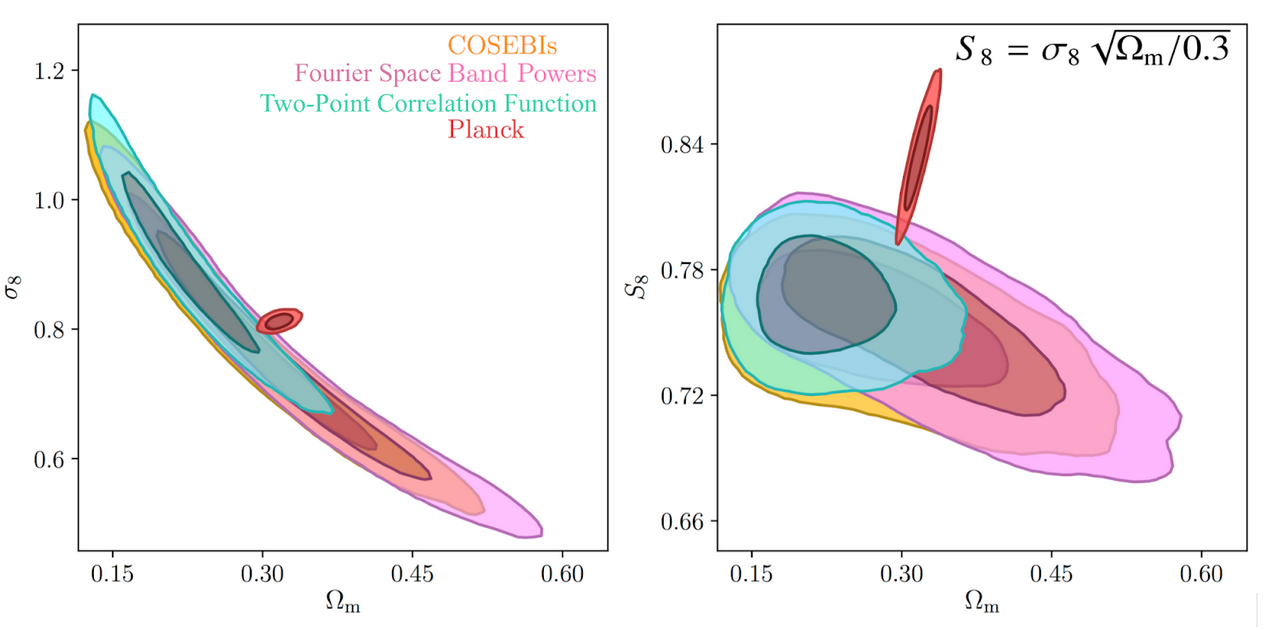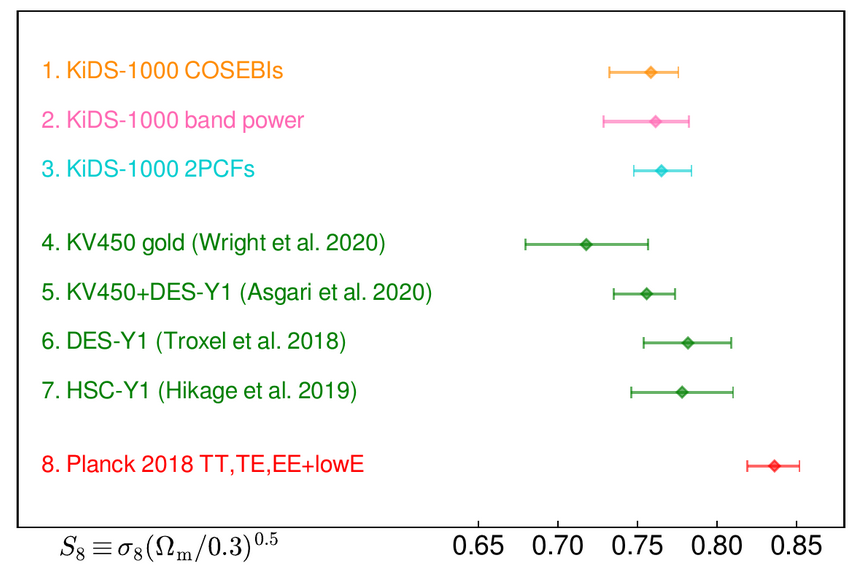KiDS-1000 cosmology: Cosmic shear constraints and comparison between two point statistics
Welcome to the KiDS-1000 cosmic shear page. Here you can find the data products from the analysis of Asgari, Lin, Joachimi et al 2020. This analysis is performed on the 4th KiDS data release, which includes 1006 square degrees of images as described in Kuijken, Heymans, Dvornik, Hildebrandt, de Jong, Wright, Erben et al 2019. The production and validation of the shear catalogues are detailed in Giblin, Heymans, Asgari et al 2021, while Hildebrandt, van den Busch, Wright et al 2021 reports the redshift distribution of galaxies and their calibration. We further point interested individuals to Joachimi, Lin, Asgari, Tröster, Heymans et al 2021 which complements the cosmic shear analysis with details of the methodology that was employed there.
This Cosmology Talk seminar summarises the main results.
Paper
KiDS-1000 Cosmology: Cosmic shear constraints and comparison between two point statistics
Marika Asgari, Chieh-An Lin, Benjamin Joachimi, Benjamin Giblin, Catherine Heymans, Hendrik Hildebrandt, Arun Kannawadi, Benjamin Stölzner, Tilman Tröster, Jan Luca van den Busch, Angus H. Wright, Maciej Bilicki, Chris Blake, Jelte de Jong, Andrej Dvornik, Thomas Erben, Fedor Getman, Henk Hoekstra, Fabian Köhlinger, Konrad Kuijken, Lance Miller, Mario Radovich, Peter Schneider, HuanYuan Shan, Edwin Valentijn
We present cosmological constraints from a cosmic shear analysis of the fourth data release of the Kilo-Degree Survey (KiDS-1000), doubling the survey area with nine-band optical and near-infrared photometry with respect to previous KiDS analyses. Adopting a spatially flat ΛCDM model, we find S8=σ8(Ωm/0.3)0.5=0.759+0.024-0.021 for our fiducial analysis, which is in 3σ tension with the prediction of the Planck Legacy analysis of the cosmic microwave background. We compare our fiducial COSEBIs (Complete Orthogonal Sets of E/B-Integrals) analysis with complementary analyses of the two-point shear correlation function and band power spectra, finding results to be in excellent agreement. We investigate the sensitivity of all three statistics to a number of measurement, astrophysical, and modelling systematics, finding our S8 constraints to be robust and dominated by statistical errors. Our cosmological analysis of different divisions of the data pass the Bayesian internal consistency tests, with the exception of the second tomographic bin. As this bin encompasses low redshift galaxies, carrying insignificant levels of cosmological information, we find that our results are unchanged by the inclusion or exclusion of this sample.
Fiducial Results
We use three sets of two-point statistics in our analysis of the KiDS-1000 cosmic shear data. his Figure shows the marginalised constraints for the joint distributions of σ8 and Ωm (left), as well as S8 and Ωm (right). The 68% and 95% credible regions are shown for COSEBIs (orange), band powers (pink) and the 2PCFs (cyan). Planck (2018, TT,TE,EE+lowE) results are shown in red.

A comparison between our results and external analyses show good agreement between cosmic shear results.

Download the Data products
The fiducial analysis of the KiDS-1000 cosmic shear data uses COSEBIs, which are insensitive to small multipoles and provide the best goodness-of-fit out of the three sets of statistics. The data products used to produce the figures above can be downloaded as a tarball.
The tarball includes
- The sampled posteriors in the form of Multinest chains,
- Fits files that include the data vectors, the covariance matrices and the redshift distribution of galaxies.
- The covariance matrix of the uncertainty in the redshift distributions.
- CosmoSIS configuration files (*.ini) to run the chains using the KiDS Cosmology Analysis Pipeline KCAP
- Plotting script for the cosmic shear chains in the figure above using chainconsumer.
Contacts
Any questions? Please contact Marika Asgari (ma[at]roe.ac.uk)
Acknowledgment
We welcome independent analyses of the KiDS-1000 data products, provided that KiDS is acknowledged in any resulting publications. Users of these data are required to include the following statement in their paper:
Based on observations made with ESO Telescopes at the La Silla Paranal Observatory under programme IDs 177.A-3016, 177.A-3017, 177.A-3018 and 179.A-2004, and on data products produced by the KiDS consortium. The KiDS production team acknowledges support from: Deutsche Forschungsgemeinschaft, ERC, NOVA and NWO-M grants; Target; the University of Padova, and the University Federico II (Naples).
Additionally, any publications should cite the relevant KiDS-1000 papers as follows:
We use the gold sample of weak lensing and photometric redshift measurements from the fourth data release of the Kilo-Degree Survey (Kuijken et al. 2019, Wright et al. 2020, Hildebrandt et al. 2021, Giblin et al 2021), hereafter referred to as KiDS-1000. Cosmological parameter constraints from KiDS-1000 have been presented in Asgari et al 2021 (cosmic shear), Heymans et al 2021 (3x2pt) and Tröster et al 2021 (beyond ΛCDM), with the methodology presented in Joachimi et al 2021.
